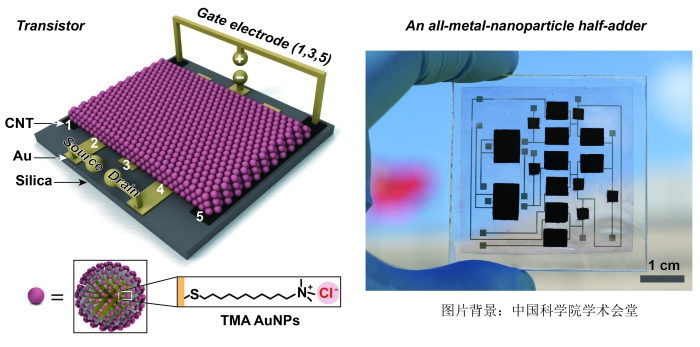A research team led by Prof. YAN Yong from the National Center for Nanoscience and Technology (NCNST) of the Chinese Academy of Sciences (CAS), collaborating with Profs. LI Tiehu from Northwestern Polytechnical University and Bartosz Grzybowski from Ulsan University of Science and Technology (UNIST) reported a transistor and logic circuits created exclusively from thin films of metal nanoparticles. This finding was recently published in Nature Electronics (DOI: 10.1038/s41928-020-00527-z). 
The capability of electrically modulating the charge carrier concentration and/or the conductivity of the semiconductor materials is the essential characteristics for their wide applications in electronic devices. This tunable conductivity feature is, however, challenging to achieve for metallic materials in which metals screen the electric field and therefore, their electrical resistance is insensitive to applied field.
In this work, the research team show that the conductivity of a metal nanoparticle thin layer can be electrically modulated by creating dynamic counterion gradients around the charged nanoparticles. This characteristic enabled the researcher to build transistors via an unconventional five-electrode configuration.
The proof-of-the-concept devices can achieve an on/off ratio up to approximately 400, can perform ‘NOT’ logic and simple computations (e.g. half-adder), consists of non-toxic nanoparticles casted from alcohol solutions, and is mechanically flexible for circuit integrations. In addition, because the ionic nanoparticles are hydrated and screened by counterions, the devices can withstand electrostatic discharges.
Finally, the researcher proposed the possibility to integrate multi-properties of metal nanoparticles achieved by modifying nanocores with chemically/biologically functionalized SAMs. One can envision that such combinations would generate much complex platforms that can not only carry out sensing functions but also perform logic operations, displaying self-learning memory and processing capabilities.
This work was supported by the Strategic Priority Research Program of Chinese Academy of Sciences and the National Natural Science Foundation of China.

Figure | left: Architecture of a metal nanoparticle thin-film transistor (top) and the scheme of an individual charged TMA gold nanoparticle (bottom). right: Photograph of an all-metal-nanoparticle half-adder.
Contact:
YAN Yong
National Center for Nanoscience and Technology




